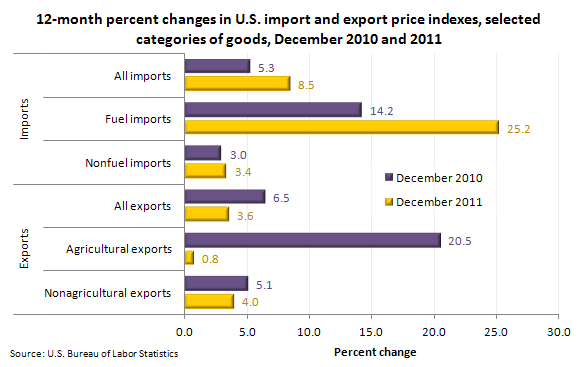January 17, 2012 (The Editor’s Desk is updated each business day.)
Import and export prices in 2011
The price index for overall imports rose 8.5 percent in 2011, driven by a 9.2-percent increase for the index over the first five months of the year. 2011 was the third consecutive year that import prices rose, advancing 5.3 percent and 8.6 percent, respectively, in 2010 and 2009, after declining 10.1 percent in 2008.

[Chart data]
Despite falling 3.4 percent since April, overall fuel prices advanced 25.2 percent in 2011, as a 27.4-percent rise in petroleum prices more than offset a 9.4-percent drop in natural gas prices. Fuel prices advance 14.2 percent in 2010 and 62.2 percent in 2009.
Nonfuel import prices advance 3.4 percent over the past year after rising 3.0 percent in 2010. Higher prices for nonfuel industrial supplies and materials; foods, feeds, and beverages; and finished goods all contributed to the 2011 increase in nonfuel prices.
The price index for overall exports rose 3.6 percent in 2011 after rising 6.5 percent in 2010 and 3.4 percent in 2009.
Agricultural export prices advanced 0.8 percent in 2011 despite falling 7.4 percent in the final quarter of the year. Agricultural prices rose 20.5 percent in 2010 and 9.2 percent in 2009 in contrast to the relatively small increase in 2011. The rise in agricultural prices in 2011 was driven by a 28.1-percent increase in vegetable prices and a 7.9-percent advance in corn prices.
Prices for nonagricultural exports rose 4.0 percent in 2011 after a 5.1-percent increase the previous year and a 2.9-percent advance in 2009.
These data are from the International Price program. Import and export price data are subject to revision. For more information, see "U.S. Import and Export Price Indexes — December 2011" (HTML) (PDF), news release USDL-12-0028.
Related TED articles
International comparisons |
Prices
Of interest
Spotlight on Statistics: National Hispanic Heritage Month
In this Spotlight, we take a look at the Hispanic labor force—including labor force participation, employment and unemployment, educational attainment, geographic location, country of birth, earnings, consumer expenditures, time use, workplace injuries, and employment projections.
.
Read more »
